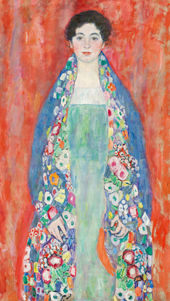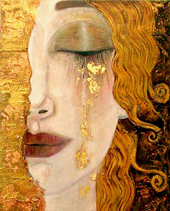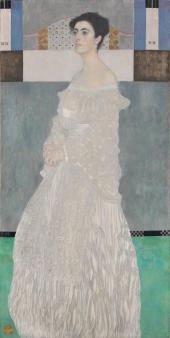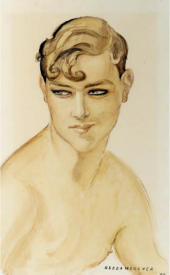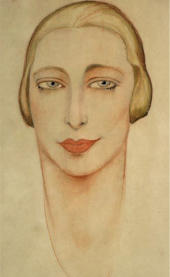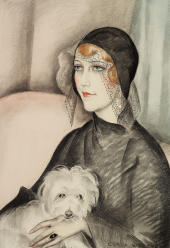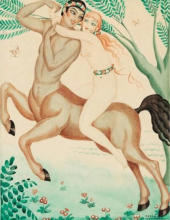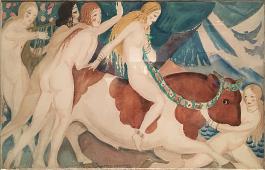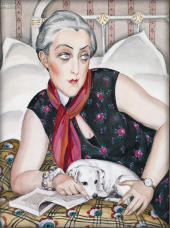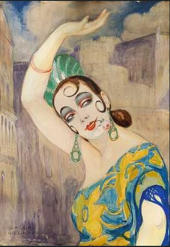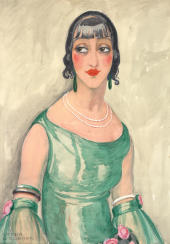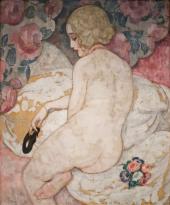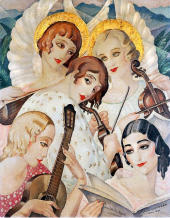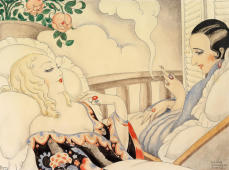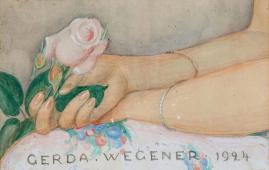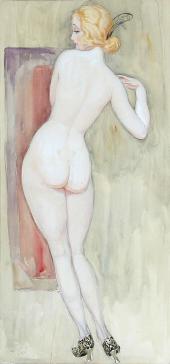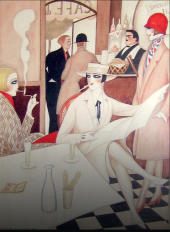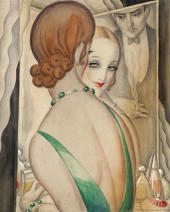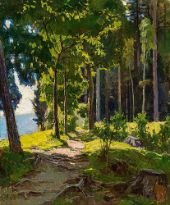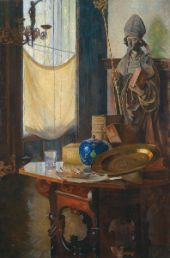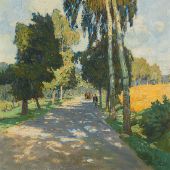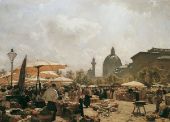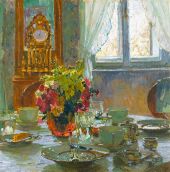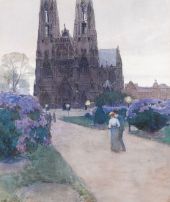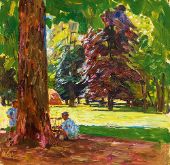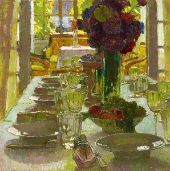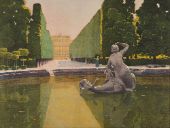Art Nouveau Oil Painting Reproductions
Find Art Nouveau oil painting replicas by Art Nouveau artists
Art Nouveau Artworks: A Brief Introduction
Art Nouveau was a global phenomenon emerging in the 1890s. Encompassing fine arts, architecture, interior design, and fashion, it brought an entirely new, elegant aesthetic to creative endeavors. Characterized by flowing lines, geometric forms, symbolic figures, and floral ornamentation, the movement flourished in the late 19th and early 20th centuries. However, like many avant-garde artistic developments, it petered out with the horrors of the First World War.
In this brief introduction, we look at the defining characteristics of this movement, its famous oil paintings, and its famous artists.
What is Art Nouveau?
The aim of Art Nouveau artists is Gesamtkunstwerk meaning 'total work of art.' The concept involves incorporating fine and applied arts in everyday life, including furniture, book illustration, painting, music, architecture, and design. Art Nouveau creations feature train stations, department stores, private houses, and public restaurants today. Alongside Symbolism art, emerging around the same time, the movement prioritized ideas and style over realistic depictions. Instead, their stylish, elegant creations focused on psychological, mystical effects. They frequently revolve around themes of love, fear, death, and unrequited desire. Although it was a global movement, it was especially prominent in France and Britain. However, it came to a broader audience after the 1900 Exposition Universelle. It preceded the Art Deco movement.
Art Nouveau artists firmly believed beautiful objects should be part of everyday life. They consequently created decorative arts featuring intertwining leaf and tendril motifs, organic curvaceous forms, birds, flowers, and beautiful women. Elongated geometric shapes and straight lines contrast with curved forms.
Who is the founder of Art Nouveau?
The term stems from a Belgian art journal L’Art Moderne. Coined in 1884, it refers to a group of like-minded painters, designers, and sculptors. Named Les Vingts (or Les XX), their founding members include James Ensor and Theo van Rysselberghe. The spirit of the Art Nouveau movement quickly traveled throughout Europe. Its reach is varied and widespread, known as Jugendstil, Modernismo, Secession, and Stile Floreale.
In addition, a Parisian gallery named La Maison de L’Art Nouveau also emerged. Owned by the avant-garde collector Siegfried Bing, he displayed works from the Art Nouveau art movement. After the 1900 Exposition Universelle, the Paris World’s Fair, the gallery’s name was synonymous with the style. In Britain, the movement followed a distinct path. Here, the work of Charles Rennie Mackintosh notably defined the style. Mackintosh employed the typical Art Nouveau flowing lines and organic shapes as an architect, designer, and artist. He combined these with more severe geometric shapes, often creating long floral forms adorning his furniture, buildings, and painterly compositions. Inspired by William Morris and the Arts and Crafts Movement, it responded to growing industrialization and factory mass production.
What defines Art Nouveau Artworks?
Unlike many other artistic movements, it did not espouse a particular philosophy. Instead, production was predominantly a matter of style. Nonetheless, specific ideas define the Art Nouveau movement. From the outset, artists advocated the unity of all the arts. They argued against discrimination between fine art painting and sculpture and the so-called lesser decorative arts. Art Nouveau painters expressed a desire to push beyond artistic historicism. Consequently, artworks are freshly analyzed natural forms. The results are beautiful creations, with decoration and function merging as one. A single look or mood does not define the movement. Instead, an artistic focus on organic nature, contrasting with the modern machine age, was a critical defining feature.
In terms of famous Art Nouveau paintings, it doesn’t get more iconic than The Kiss by Gustav Klimt. Klimt's 1907 painting represents a glittering example. Gustav Klimt's Lady with a Fan is one of our most popular paintings and one of the last oil paintings he created before he died in 1918.
What are the main characteristics of Art Nouveau paintings?
Art Nouveau paintings often feature flowing, curved lines. Elegant, elongated forms combine with organic plant-based shapes to create a stylish yet natural effect.
In addition, there are three overarching characteristics. These include:
- The artistic design applies to everyday objects and scenes. Nothing is too useful to be beautiful.
- The lack of separation between fine art, painting, sculpture, and decorative arts such as furniture, ceramics, and practical objects.
- A response to the dominating geometry and precise compositions of Neo-Classicism. Art Nouveau paintings moved away from the strict rules of leading artistic institutions.
What are the most famous Art Nouveau Paintings?
Gustav Klimt The Kiss remains one of the most famous oil paintings. Originally titled Liebespaar or The Lovers, it also deals with classic themes of love, longing, life, and death. Delicate floral motifs decorate the woman’s dress, and a floating meadow supports the two lovers. The figures contrast with the solid geometric forms of the man’s cloak and the sinuous lines of the couple’s bodies. The painting develops themes seen in earlier Klimt artworks such as the Beethoven Frieze, The Hostile Powers 1902. Indeed, Klimt's Frieze series of paintings honor the great composer Ludwig Van Beethoven. Initially destined for the Vienna Secession 1914 exhibition, the painting conveys the power and feeling of his music through visual arts. Like The Kiss painting, the figures appear amidst shining golden tones in a dark and erotically charged scene.
While this introduction focuses on paintings, other well-known Art Nouveau creations exist. They include the Paris Metro station entrances, designed by Hector Guimard, Tiffany’s iconic glass creations, and Charles Rennie Mackintosh’s chair designs. The Glasgow School of Art building and iconic and ethereal book illustrations from Aubrey Beardsley and Arthur Rackham reflect the Art Nouveau movement.
Who are the leading Art Nouveau Artists?
The movement was broad, inspiring many famous artists working all over the world. In addition to famous figures such as Gustav Klimt, five Art Nouveau artists championed the genre.
Jan Toorop 1858-1928
As a Dutch-Indonesian painter, Jan Toorop worked across multiple styles, including Symbolism, Art Nouveau, Pointillism, and Impressionism. He lived in Brussels from 1882 to 1886, where he joined Les XX, led by James Ensor.
Toorop’s later works are the most distinctly Art Nouveau. His painting, Fatality, is one example where Toorop plays with sinuous lines to striking effect. The combination of black and yellow sweeping forms also appeared in Toorop’s commercial work, such as his deep Art Nouveau Poster for Delft Salad Oil.
Alphonse Mucha 1860-1939
Alphonse Mucha was a Czech painter, graphic artist, and movement pioneer. Mucha is best known today for his decorative and beautifully stylized theater posters featuring the actress Sarah Bernhardt. Gismonda 1890 is one of the earliest of Alphonse Mucha’s posters, featuring classic motifs such as stylized typography, ornamental flowers, and a long, flowing Japonism-inspired outfit. As well as these posters, Mucha also produced decorative panels, illustrations, and advertisements. As a result, they are now some of the most recognizable Art Nouveau images.
Henri de Toulouse Lautrec 1864-1901
Another early pioneer of the Art Nouveau movement, Henri de Toulouse Lautrec, created some of the movement’s most familiar images. His immersion in 19th century Paris's colorful, theatrical world produced unique artistic insight into contemporary society. Lautrec paintings, such as At the Moulin Rouge 1892, see well-dressed faces and stylish shadowy figures peering eerily out of the composition. In addition to oil on canvas paintings, Lautrec produced famous Art Nouveau posters for leading Paris institutions such as Reine de Joie and Moulin Rouge La Goulue.
Tom Thomson 1877-1917
A Canadian artist, Tom Thomson was incredibly influential during his short career. However, he sadly died, aged just 39, from accidental drowning. Nonetheless, Thomson produced 400 oil sketches and 50 oversized canvas paintings, mostly depicting his native Ontario landscape. His Art Nouveau sensibilities are apparent in works such as Decorative Panel, featuring a single, stylized tree. Indeed, the theme of single or small groups of trees is prevalent in Art Nouveau. They hark back to the “lone hero” idea in works such as The Lonely Tree by Caspar David Friedrich and Autumn Tree with Fuschias by Egon Schiele.
Gerda Wegener 1886-1940
Gerda Wegener was a Danish painter and illustrator. Her paintings pushed the boundaries of gender identity, love, and sensuality. They caused a sensation in interwar society. Indeed, Wegener’s Lili Elbe paintings are amongst the earliest examples of transgender art. Wegener's pioneering paintings utilize strong Art Nouveau sensibilities to portray Lili Elbe, a transgender woman and Wegener’s long-term partner. As a result, many Gerda Wegener paintings, classed as “lesbian erotica” at the time, proved shocking to contemporary audiences. These artworks include oil paintings such as Lily Hot Summer 1924 and Les Femmes Fatales 1933.
Art Nouveau Paintings: Art Reproductions
If you love the beauty and elegance of Art Nouveau artworks or Art Deco paintings, discover our extensive collection of replica art.
Enjoy museum-quality oil paintings on canvas by famous artists Gustav Klimt, Alphonse Mucha, Jan Toorop, Gerda Wegener, and her Lili Elbe paintings.
We have been creating reproduction oil paintings since 1996. GLOBAL SHIPPING IS FREE.
Testimonial from CB, Arlington, VA
Cannot Find What You Are Looking For?
Reproduction Gallery Information
Customer Service
(Send Us A Message)
Tel: (503) 937 2010
Fax: (503) 937 2011



